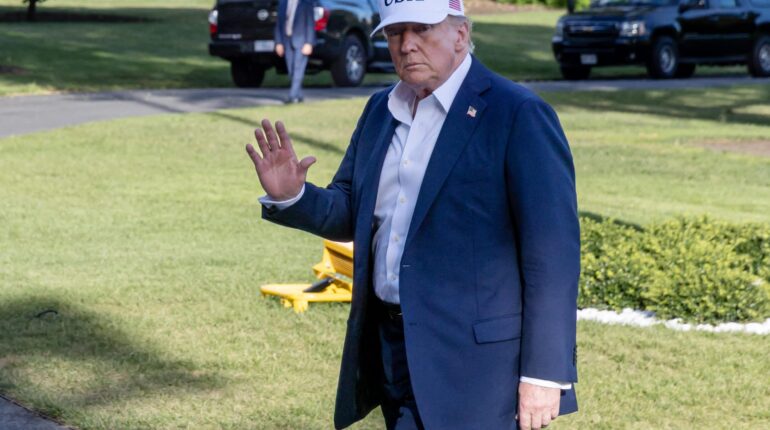📌 Trump threatens 40% tariffs on 14 countries: “Any retaliation will be added to the rate”

Posted 8 July 2025 by: Admin
Trump’s Tariff Blitz: 14 Countries Face Steep Import Duties Starting August 1
President Donald Trump unleashed a sweeping tariff offensive Monday, targeting 14 countries with punishing import duties that will reshape global trade dynamics starting August 1. The announcement, delivered through a series of calculated social media posts, signals the most aggressive trade escalation since his return to office.
The president revealed the tariff rates by sharing screenshots of official form letters addressed to world leaders across four continents. Japan, South Korea, Malaysia, Kazakhstan, and Tunisia will face 25% tariffs on their exports to the United States. South Africa and Bosnia and Herzegovina received notices of 30% duties, while Indonesia confronts a 32% excise tax.
The escalation intensifies for Bangladesh and Serbia, both hit with 35% tariff rates. Cambodia and Thailand face 36% duties, marking them among the most severely impacted nations in Trump’s trade war arsenal.
But the harshest punishment awaits Laos and Myanmar, which will confront 40% tariffs – the steepest rates in the entire package. These crushing duties represent the administration’s most aggressive stance yet against nations Trump claims have exploited American trade relationships.
The president’s unconventional announcement strategy – posting official diplomatic correspondence on Truth Social – underscores his preference for direct communication over traditional diplomatic channels. The letters, bearing Trump’s signature, arrived in leaders’ inboxes simultaneously with their public release online.
Originally scheduled to take effect Wednesday, the tariff implementation received an unexpected reprieve when Trump signed an executive order Monday afternoon delaying the deadline until August 1. The administration cited « additional information and recommendations from various senior officials » as justification for the extension.
White House press secretary Karoline Leavitt confirmed that additional countries will receive similar letters « in the coming days, » suggesting the current list represents only the opening salvo of a broader tariff campaign.
The letters carry an ominous warning embedded within their diplomatic language: tariff rates may be adjusted « depending on our relationship with your Country. » This conditional phrasing transforms trade policy into a tool of diplomatic leverage, where commercial terms fluctuate based on political alignment.
Trump’s latest moves resurrect the confrontational trade approach that defined his previous presidency, setting the stage for potential global economic disruption.
The Economic Fallout: Markets Plunge As Tariff Threats Materialize
The promised economic disruption materialized within hours of Trump’s tariff announcement. U.S. financial markets closed Monday in deep red, with investors fleeing risk assets as the specter of global trade war returned to haunt Wall Street.
The Dow Jones Industrial Average plummeted 422.17 points, shedding 0.94% to close at 44,406.36. The broader S&P 500 index fell 0.79% to 6,229.98, while the tech-heavy Nasdaq Composite dropped 0.92% to finish at 20,412.52. The synchronized decline across all major indices reflected widespread investor anxiety over the trade policy escalation.
The market rout underscored the profound nervousness surrounding Trump’s protectionist agenda. Each percentage point drop represents billions in lost market value, with retirement accounts and institutional portfolios absorbing the immediate impact of renewed trade tensions.
Monday’s tariff rates represent a return to the aggressive stance Trump first unveiled during his « liberation day » announcement on April 2. Under those initial rates, Japan faced 24% tariffs while South Korea confronted 25% duties – figures that closely mirror the current targets of 25% for both nations.
The April announcement had triggered a chaotic week of global market losses, forcing Trump to implement an emergency 90-day pause on April 9. This cooling-off period reduced all tariff rates to a flat 10% across targeted countries, providing temporary relief to both markets and trading partners.
That pause was originally set to expire Wednesday, creating the deadline pressure that prompted Monday’s announcement. The extension to August 1 suggests the administration recognizes the delicate balance between maintaining negotiating leverage and avoiding economic catastrophe.
The three-month reprieve had allowed markets to stabilize and trading relationships to adjust to the new reality. However, the return to punitive rates signals that Trump views the pause as a tactical maneuver rather than a strategic retreat.
Financial analysts warn that sustained market volatility could undermine economic growth and consumer confidence. The president’s trade war now carries measurable costs that extend far beyond diplomatic tensions, creating real economic consequences for American investors and businesses.
The countdown to August 1 has begun, with markets bracing for potential escalation.
Trade Deficit Justification: Trump’s Strategy To Rebalance Global Commerce
Behind the escalation lies Trump’s fundamental trade philosophy: America’s persistent deficits with these 14 countries justify punitive action. The form letters sent to world leaders explicitly frame the new tariffs as corrective measures designed to address what the administration views as unfair trade imbalances.
The numbers reveal Trump’s selective targeting strategy. While the U.S. recorded an 8.5 billion goods deficit with Japan and a 6 billion shortfall with South Korea in 2024, Myanmar’s trade surplus amounted to merely 79.3 million dollars. Yet Myanmar faces the harshest punishment – a crushing 40% tariff rate alongside Laos.
This disparity exposes the administration’s broader message: no trade surplus, regardless of size, escapes scrutiny. Kazakhstan’s crude oil exports, Malaysia’s electronic components, and South Africa’s precious metals all face steep duties despite vastly different trade volumes and economic relationships with America.
The letters contain a sophisticated anti-circumvention mechanism targeting transshipping practices. « Goods transshipped to evade a higher Tariff will be subject to that higher Tariff, » the warnings state. This provision closes potential loopholes where companies might route products through third countries to avoid duties.
Trump’s most provocative element appears in his retaliation clause. Should any targeted country impose counter-tariffs, the letters promise escalation: « whatever the number you choose to raise them by, will be added onto the 25% that we charge. » This creates a ratcheting mechanism designed to discourage diplomatic pushback.
The president offers conditional relief for countries willing to « eliminate » their « Tariff, and Non Tariff, Policies and Trade Barriers. » Such comprehensive trade liberalization demands represent maximalist negotiating positions that few nations can realistically accept.
Trade experts question whether persistent deficits necessarily indicate unfair treatment, arguing that such imbalances often reflect natural comparative advantages and consumer preferences. The administration’s approach treats all deficits as evidence of foreign manipulation rather than market outcomes.
The August 1 deadline now looms over 14 economies, each calculating whether compliance or confrontation better serves their national interests.
Legal Challenges And Diplomatic Gambit: The Path Forward
While nations weigh their options, Trump’s tariff arsenal faces mounting legal scrutiny. A federal district court struck down his reciprocal tariffs in late May, ruling the president lacked authority to impose such sweeping duties under the emergency-powers law he cited. The administration immediately appealed, keeping the tariffs operational during the review process.
This legal vulnerability exposes the shaky foundation beneath Trump’s trade offensive. The federal circuit court’s pending decision could dismantle the entire framework, rendering August’s escalation meaningless. Yet the administration pushes forward, gambling that judicial delays will allow economic pressure to force diplomatic breakthroughs.
The president’s ambitious timeline reveals the gap between rhetoric and reality. After imposing his three-month pause in April, Trump’s team promised to strike 90 deals in 90 days. As that deadline approached, the scorecard showed minimal progress: broad frameworks with the United Kingdom and Vietnam, plus a preliminary agreement with China.
The Vietnam arrangement illustrates Trump’s negotiating template. The deal imposes a 20% tariff on Vietnamese imports alongside a 40% “transshipping” duty, while granting the U.S. tariff-free access to Vietnam’s markets. This asymmetric structure demands unilateral concessions from trading partners.
Trump’s letters hint at potential flexibility through carefully crafted language. Tariffs « may be modified, upward or downward, depending on our relationship with your Country, » the messages state. This diplomatic opening creates space for bilateral negotiations while maintaining maximum pressure.
The correspondence concludes with an unusual personal guarantee from the president: « You will never be disappointed with The United States of America. » This folksy assurance sits oddly alongside threats of escalating trade warfare, reflecting Trump’s transactional approach to international relations.
As August 1 approaches, the intersection of legal challenges and diplomatic maneuvering will determine whether Trump’s latest tariff gambit succeeds or collapses under constitutional constraints.




















